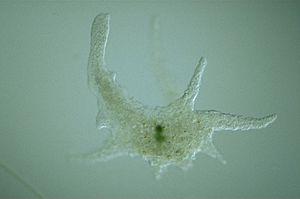Pseudopodia facts for kids
Pseudopods are like "false feet" that help tiny cells move around. They are temporary parts of a cell, filled with a jelly-like substance called cytoplasm. These false feet can change their shape, allowing the cell to crawl or grab things. Many tiny living things, like amoebas, use pseudopods to get around or to eat.
Contents
What Are Pseudopods?
Pseudopods are temporary extensions that a cell pushes out from its main body. Imagine a blob of jelly stretching out a part of itself. This stretched-out part is the pseudopod. The cell's internal jelly-like material, the cytoplasm, flows into this new "foot." Once the pseudopod is extended, the rest of the cell flows into it, and the cell has moved to a new spot.
How Do Cells Use Pseudopods?
Pseudopods are one of the main ways that single-celled organisms move. Other ways include using tiny whip-like tails called flagella or hair-like structures called cilia.
Besides moving, pseudopods also help cells "eat." They can surround tiny food particles and pull them inside the cell. This process is called phagocytosis. It's like the cell is giving the food a big hug and then swallowing it. Even some of your own cells, like white blood cells, use pseudopods to move around and fight off germs in your body!
Different Types of Pseudopods
Scientists classify pseudopods into different types based on how they look and what they do.
Lobopodia: The Blunt Ones
Lobopodia are short and blunt, like thick, rounded fingers. They are very common in amoebas.
Filopodia: The Slender Ones
Filopodia are much thinner and more thread-like, with pointed ends. They are often used for sensing the environment or for attaching to surfaces.
Reticulopodia: The Net-like Ones
Reticulopodia, also known as reticulose pseudopods, are complex. Individual pseudopods connect and blend together, forming an irregular net. This net can help the cell capture food over a wider area.
Axopodia: The Spiky Ones
Axopodia are thin and spiky pseudopods. They are covered by cytoplasm and are very good at quickly pulling back when they touch something. They are often used for capturing food, especially by tiny organisms like radiolaria and heliozoa.
Images for kids
See also
 In Spanish: Pseudópodo para niños
In Spanish: Pseudópodo para niños



